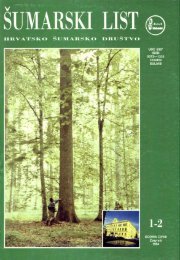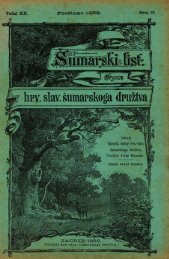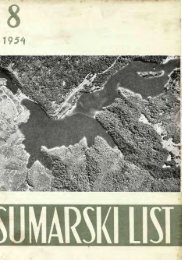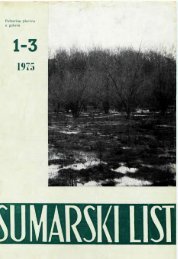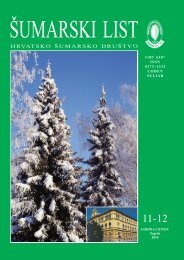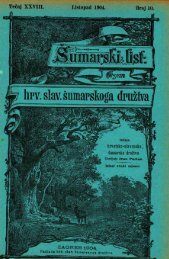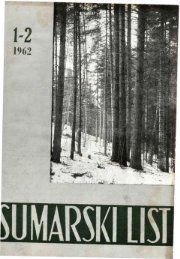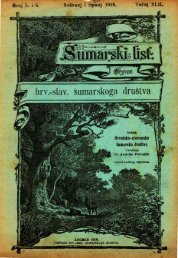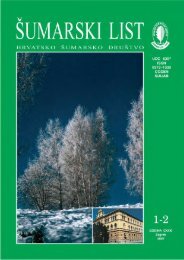You also want an ePaper? Increase the reach of your titles
YUMPU automatically turns print PDFs into web optimized ePapers that Google loves.
I. Tolić: GOSPODARSKE I DRUGI: VRIEDNOSTI VRSTA RODA PISTACIJA Šumarski list br. 9-<strong>10</strong>, CXXVI1 (<strong>2003</strong>), 501-507<br />
LITERATURA - References<br />
Giperborej ski, B., T. Marković, 1952.: Dcndrologija,<br />
Sarajevo.<br />
Petračić,A., 1955.: Uzgajanje šuma, Zagreb.<br />
Silić, Č., 1973.: Atlas drveća i grmlja, Sarajevo.<br />
Grupa autora, 1992.: Šume u Hrvatskoj - monografija,<br />
Zagreb.<br />
SUMMARY: Large degraded areas of formerly valuable high forests in the<br />
Croatian Mediterranean and sub-Mediterranean region belong to the natural<br />
distribution range of the genus Pistacia: mastic tree (Pistacia lentiscus L.)<br />
and terebinth tree (Pistacia terebinthus L.). For a long time, these species<br />
were neglected by the forestry profession, or better put, their commercial and<br />
other values were not recognised. The author of this article has not found<br />
much data on the species of the genus Pistacia in the available literature, and<br />
even less on the ameliorative properties of the Mediterranean karst. These<br />
are two autochthonous species, which have always had a significant and useful<br />
function in their natural Mediterranean range.<br />
The Mediterranean area has for centuries suffered from a shortage of all<br />
timber assortments. It is for this reason that the wood of the genus Pistacia<br />
species, and particularly of P. terebinthus, has been widely applied in woodwork,<br />
turner}' and in the manufacture of wooden tool parts, due to its hardness,<br />
firmness, easy processing and varnishing. The Pistacia wood is also good as<br />
fuelwood as it contains resin. The rooms in which it burns are permeated by a<br />
very pleasant smell. Other parts of the plants of this genus have found their use<br />
in the chemical industry, medicine, and other fields. On occasions, due to<br />
severe droughts and the absence of other cattle food in warmer parts of the<br />
Mediterranean, the leaves (bushes) were picked and dried to be used as a substitute,<br />
however inadequate, for sheep and goat food. Unripe fruits (grapes) in<br />
particular were picked and given to sheep as nourishing food.<br />
The species of this genus has not found a suitable ameliorative application<br />
in forestry although these plants have a well-developed root system and are<br />
distinctly xerophytic. They tolerate poor sites well, while their good shooting<br />
vigour makes them a constitutive part ofmaquis and warmer parts of deciduous<br />
coppices. After afire they regenerate well from stumps.<br />
Apart from the two autochthonous Croatian species, the far better known<br />
common pistachio (Tistacia vera, L.) is grown for its edible and very tasty<br />
fruit both in the Mediterranean region and wider. The intention of the author<br />
of this article is, among other things, to advocate the cultivation of this<br />
species for its fruits and enrichment of fruit tree assortment in the Croatian<br />
Mediterranean region. This possibility is particularly stressed because the<br />
two existing autochthonous species growing in their natural sites may serve<br />
as good stock for grafting the common pistachio.<br />
Key words: mastic tree, terebinth tree, common pistachio, evergreen,<br />
deciduous, plumate leaves, bush, low tree, diclinous, dioecious, entomophilic,<br />
xerophytic, sea spray, Mediterranean, fruit, drupe, seed, edible, tasty, nourishing,<br />
cultures, mastic, root system




